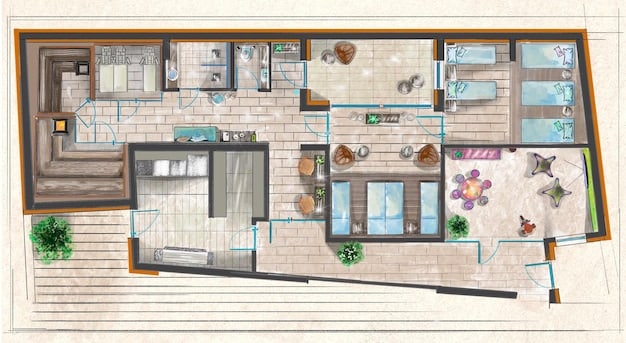Build a Home Office: Expert Tips for Converting Your Spare Room

Anúncios
Transforming a spare room into a productive home office involves careful planning, functional design, and the right equipment to create an inspiring and efficient workspace.
Ready to boost your productivity and finally tackle that neglected spare room? Let’s explore how to build a home office: convert a spare room into a productive workspace that suits your needs and style.
Anúncios
Planning Your Productive Workspace
Creating an effective home office starts with a solid plan. Consider your work habits, needs, and available space to design a workspace that fosters productivity and well-being.
Begin by assessing your requirements. What type of work will you be doing? Do you need a quiet space for focused tasks or a more collaborative area for meetings? Understanding your needs will guide the layout and design choices.
Anúncios
Assessing Your Needs
Before you start moving furniture, consider what equipment and resources you need to perform your job efficiently. This will determine the size and scope of your office space.
Space Evaluation
Carefully evaluate the size and layout of your spare room. Note any architectural features, such as windows, doors, and electrical outlets, as these will influence your design decisions.
- Consider natural light and ventilation to create a comfortable environment.
- Measure the room accurately to ensure furniture fits well without overcrowding.
- Identify potential noise sources and plan for soundproofing solutions.
Effective planning ensures that your home office meets your functional needs and promotes a comfortable and productive work environment. By carefully assessing your needs and your space, you can avoid costly mistakes and create a workspace that aligns with your goals.

Designing for Functionality and Comfort
Once you have a plan, it’s time to design a functional and comfortable workspace. Prioritize ergonomics, storage solutions, and aesthetics to optimize your productivity.
Ergonomics is crucial for preventing strain and discomfort during long work hours. Invest in a high-quality ergonomic chair, adjustable desk, and monitor stand to maintain good posture.
Ergonomic Essentials
Investing in ergonomic equipment is one of the best things you can do for your health and productivity when you build a home office: convert a spare room into a productive workspace. Here’s how to choose key items:
Storage Solutions
Keep your home office organized with smart storage solutions. Utilize shelves, cabinets, and drawer units to store documents, supplies, and equipment. A clutter-free environment reduces distractions and enhances focus.
- Choose storage units that complement the room’s décor and maximize vertical space.
- Label shelves and drawers to easily locate items.
- Consider multi-functional furniture with built-in storage options.
By designing for functionality and comfort, you create a workspace that supports your well-being and enhances your productivity. Prioritizing ergonomics, storage, and an inviting atmosphere contributes to a more satisfying and effective work experience.
Essential Equipment and Technology
To work efficiently from home, you need the right equipment and technology. From computers and internet connectivity to peripherals and communication tools, ensure you have everything you need to perform your job effectively.
A reliable computer is the backbone of any home office. Choose a desktop or laptop that meets your job requirements, whether it’s graphic design, video editing, or simple word processing.
Selecting the Right Computer
Consider these factors when selecting a computer for your home office:
Internet and Connectivity
A stable and fast internet connection is essential for remote work. Ensure you have a reliable internet provider and consider upgrading your plan for faster speeds if necessary. Set up a secure Wi-Fi network and consider using a wired connection for critical tasks.
- Invest in a high-speed internet plan to support video conferencing and large file transfers.
- Use a Wi-Fi extender or mesh network to ensure consistent coverage throughout your home.
- Secure your network with a strong password and encryption.
Having the right equipment and technology enables you to perform your job effectively and efficiently from home. Prioritize reliability, functionality, and compatibility to create a seamless and productive work environment.

Lighting and Atmosphere
The lighting and atmosphere of your home office can significantly impact your mood and productivity. Create a well-lit and inviting space that promotes focus and well-being.
Natural light is ideal for a home office, so position your desk near a window if possible. Supplement natural light with artificial lighting to ensure adequate illumination throughout the day.
Maximizing Natural Light
Take full advantage of natural light to brighten your workspace and boost your mood. Natural light reduces eye strain and promotes a more positive and energetic environment.
Artificial Lighting Solutions
Supplement natural light with a combination of ambient, task, and accent lighting. Ambient lighting provides overall illumination, while task lighting focuses on specific work areas, and accent lighting adds visual interest.
- Use adjustable desk lamps to direct light where you need it most.
- Consider LED bulbs for energy efficiency and long-lasting performance.
- Incorporate warm-toned lighting to create a cozy and inviting atmosphere.
A well-lit and inviting atmosphere in your home office enhances your focus and mood, leading to increased productivity and well-being. Maximize natural light, supplement with artificial lighting, and personalize the space to create an environment that inspires creativity and efficiency.
Personalizing Your Workspace
Your home office should be a reflection of your personality and style. Add personal touches to create a space that inspires you and makes you feel comfortable and motivated.
Incorporate elements that resonate with you, whether it’s artwork, plants, photos, or decorative objects. Surrounding yourself with things you love can boost your creativity and overall job satisfaction.
Adding Personal Touches
Make your home office a space you enjoy spending time in by adding elements that reflect your interests and personality.
Creating an Inspiring Environment
An inspiring environment can boost your creativity and motivation. Consider these tips for creating a space that inspires you:
- Display artwork that you find visually appealing and stimulating.
- Add indoor plants to bring life and colour into the room.
- Personalize the space with photos, mementos, and decorative objects that make you happy.
By personalizing your workspace, you can create a space that inspires creativity, boosts job satisfaction, and enhances your overall well-being.
Maintaining Productivity and Well-being
Working from home can be challenging, so it’s important to implement strategies for maintaining productivity and well-being. Establish a routine, take breaks, and set boundaries to avoid burnout.
A consistent daily routine helps you stay focused and organized. Set specific work hours, schedule breaks, and stick to a regular sleep schedule to maintain a healthy work-life balance.
Establishing a Routine
Set a structure, when you build a home office: convert a spare room into a productive workspace, in order to stay productive and avoid some of the potential challenges of working from home.
Taking Breaks and Setting Boundaries
Regular breaks are essential for preventing fatigue and maintaining focus. Get up and move around, stretch, or do something you enjoy during your breaks.
- Take short breaks every hour to stretch and move around.
- Schedule longer breaks for lunch and other activities.
- Set clear boundaries between work and personal time to avoid burnout.
By maintaining productivity and well-being, you can enjoy the benefits of remote work without sacrificing your health. A well-balanced approach to work and life ensures that you stay motivated, focused, and energized.
| Key Point | Brief Description |
|---|---|
| 📐 Plan Your Space | Assess needs and space to design efficiently. |
| 💺 Ergonomic Setup | Invest in a chair and desk for good posture. |
| 💡 Lighting is Key | Optimise natural and artificial lighting for comfort. |
| 📅 Routine & Breaks | Maintain a schedule and take regular breaks to stay focussed. |
FAQ
▼
Position your desk near a window to maximize natural light, which can boost your mood and reduce eye strain. Avoid placing your desk directly in front of a window if glare becomes an issue, and ensure you have adequate artificial lighting for evenings or cloudy days.
▼
Add soft materials like rugs, curtains, and upholstered furniture to absorb sound. Consider using acoustic panels on the walls to reduce echo. If outside noise is a problem, try using a white noise machine or noise-canceling headphones to minimise distractions.
▼
Use cable ties, sleeves, or cord organizers to group and manage cables neatly. Mount a power strip under your desk to keep cords off the floor. Label each cable to easily identify what it’s connected to. This will reduce clutter and prevent tripping hazards.
▼
Standing desks can reduce back pain, improve posture, and burn more calories compared to sitting. They can also increase energy levels and focus throughout the day. Alternating between sitting and standing can help you stay more alert and productive.
▼
Plants improve air quality by absorbing toxins and releasing oxygen. They also add a touch of nature, which can reduce stress and increase creativity. Choose low-maintenance plants like snake plants, spider plants, or succulents to add greenery without requiring too much care.
Conclusion
Converting a spare room into a productive home office involves careful planning, thoughtful design, and the right equipment. By prioritizing functionality, comfort, and personalization, you can create a workspace that supports your well-being and enhances your productivity. A successful home office is not just a space; it’s an investment in your professional and personal growth.





